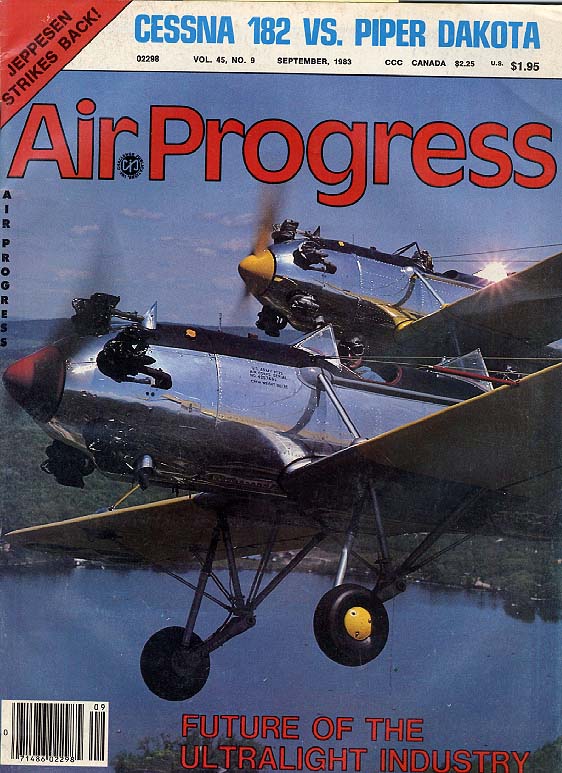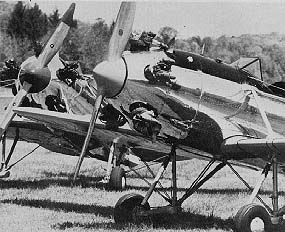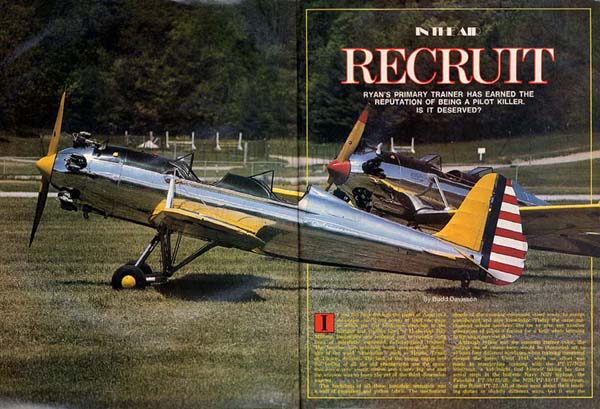

If you flip back through the pages of America's memories, you'll run across at least one page in which the flat landscape stretches to the horizon and endless lines of khaki-clad Ray Milland look-alikes are trooping out to equally long lines of colorfully costumed, radial engined trainers. The location was generally some geographical definition of the word "desolation" such as Hondo, Texas or Tucson, Arizona. The look of the young eagles in all of the old photographs are the same: this was a very young nation and a very big war and the mission was to learn the art of the third-dimension warrior.
The backdrop of all of those nostaglic scenarios
was a wall of propellers and yellow fabric. The mechanical steeds
of the training command stood ready to accept punishment and give
knowledge. Today, the same mechanical school teachers live on
to give yet another generation of pilots a feeling for a time
when learning to fly was a survival skill, not a luxury.
Although yellow was the common trainer color, the endless sea
of young faces would be channeled off to at least four different
airplanes when training command opened the gates. Until 1943,
when an effort was made to standardize training with the PT-17/N2S
Stearman, a kid might find himself taking his first aerial steps
in the bulbous Navy N3N biplane, the Fairchld PT-19/23/26, the
Stearman or the Ryan PT-22. All of these went about their teaching
duties in slightly different ways, but it was the Ryan PT-22 Recruit
that stuck out as being truly different. That "difference"
still exists today and gives rise to continuing cycles of controversy.
"PT," for primary training, was-as the name im-plies-training at the most primary level. It was, if nothing else, the final step in weeding out the true barf-bag specialist. It was a way of testing a candidate's acclamation to a new element and at the same time taught the very basics of aviating. They didn't worry about FARs, DMEs, VORs or up-side-down wedding cakes. What these instructors, aircraft and students were concerned with was the very basic concept of stick and rudder flying. Apparently, however, there was a conceptual difference as to the type of personality a trainer should have to be a good teacher.
 The Stearnian was
a tank of a biplane. It was big and re-defined the term "robust."
The absolute sole of docility, it could keep your feet busy on
the runway, yet allow you to expand your mind in the air. In essence,
the N3N and the Fairchild PT-19/23/26 could be described the same
way. This could not be said about the Ryan PT-22 Recruit.
The Stearnian was
a tank of a biplane. It was big and re-defined the term "robust."
The absolute sole of docility, it could keep your feet busy on
the runway, yet allow you to expand your mind in the air. In essence,
the N3N and the Fairchild PT-19/23/26 could be described the same
way. This could not be said about the Ryan PT-22 Recruit.
Streamlined and dainty by comparison, the PT-22 could teach its students things the Stearman never heard of. Supposedly its four degree, 10 minute swept back wing was designed specifically to give unstable stall characteristics, such as those the students would encounter in the airplanes they would soon graduate to. This could be an old wives tale since it would seem more logical that this sweepback was introduced to correct a center of gravity problem. It was also the most heavily wing loaded of the trainers, which meant ignoring the air speed on a botched approach could, and did, result in a disproportionate number of bent airplanes. There are many who agree that the PT-22 bears much more relationship to the AT-6 Texan then its primary trainer brethren.
Today, the PT-22 lives on in a love-it-or-leave-it environment. It's impossible to discuss the little air-plane without stall-spin horror stories running rampant.
At the same time, however, you'll run across guys like Bill Ahern and Eric Friedrichsen who have nearly a decade of PT-22 flying behind them. Both of their Connecticut-based airplanes are products of John Gokchoff's PT-22 production company, Component Air Inc. at Santa Paula Airport in Southern California. Gokchoff builds up brand new PT-22s, including converting them to little fighters with Ranger 200s in the nose. Both Ahern and Friedrichsen picked up their airplanes in Santa Paula and flew their 100 mile-an-hour way eastward with faith in God and Gokchoff's ability with Kinner engines.
As with most PT-22 pilots, Ahern and Friedrichsen think the PT-22's reputation as a potential killer is unearned.
"Just fly it the way its supposed to be flown," says Ahern, "And it will never bite you." Of course that leaves some interpretation on the way "it's supposed to be flown."
Both pilots freely admit that a significant portion of the airplane's supposed problems stem from the fact that "militarizing" the STA added 400 lbs of flab that the light little STA didn't have. As originally designed, with a Menasco engine, the military found the STA to be unsuited for the rigors of flight training. They set about beefing it up which included replacing the easy-to-break Menasco with a bullet-proof boat anchor called a Kinner with 160 low-rpm horse-power. They also moved the fuselage stringer extru-sions outboard, opened up the cockpit area for easier entry with a parachute. They also widened the landing gear, replaced all of the hinges with meaty ball-bearing affairs and generally messed around with the airframe until they had soured much of the sweetness that was the STA.

When we saddled up with Friedrichsen, to poke around in the Ryan's aerial innards, we found that there were two sides to the story and both sides were correct! It does have some peculiar handling charac-teristics, but they are peculiar only because you don't expect them in an airplane that's suppose to be a primary trainer. If it were called the BT or an AT-22 there wouldn't be much controversy because you would expect the machine to be a little more demanding and a little less forgiving, which it is.
Take off, or anything requiring power for that matter, can best be described as "leisurely." Some of this can be attributed to the relatively obesity of the airplane in comparison to the STA, but more of it has to do with the mental attitude of the Kinner engine. If you are standing by the side of the runway, when the PT-22 takes off, you keep waiting for the pilot to put full throttle on. Even going full bore down the runway, with the tail in the air, the little five cylinder pop-pop sounds like its running at a fast idle. At a take-off rpm of around 1700, it IS running at a fast idle compared with most modern engines. Because of this we'll-get-there-eventually feeling, the airplane has recommended take off procedures which involve picking the tail up to a slightly tail-low attitude and letting the airplane fly itself off the ground when it's ready. That way the pilot is not asking the airplane to do something it really doesn't want to do. The take-off run and all ground handling is straightforward with absolutely no tendency to wander one direction or the other. The rudder and tailwheel are perfectly capable of taking care of whatever steering duties are required. Which is a damn good thing because the PT-22s have notoriously rotten brakes according to Friedrichsen.
 Climb out at 80
miles an hour is leisurely (that word again). Eric said that he
has gotten as much as 1000 feet a minute, when the air is cold
and fat and when the airplane is light. However, all we got was
maybe 500-600 feet a minute, which he says is typical. The PT-22
is one of those airplanes in which both weight and density altitude
can be critical factors. Reportedly, density altitude is one of
the reasons the military moved the PT-22s out of the Tucson training
base to locales with cooler air.
Climb out at 80
miles an hour is leisurely (that word again). Eric said that he
has gotten as much as 1000 feet a minute, when the air is cold
and fat and when the airplane is light. However, all we got was
maybe 500-600 feet a minute, which he says is typical. The PT-22
is one of those airplanes in which both weight and density altitude
can be critical factors. Reportedly, density altitude is one of
the reasons the military moved the PT-22s out of the Tucson training
base to locales with cooler air.
Once at altitude, the airplane would putt-putt along with that peculiar Kinner rumba going on up front. In this case, it's an assymetric rhythm pattern. The cylinders on the left have short stacks while the ones on the right run into a heater muff and exit with only one stack, which makes different sounds in each air. On a clear blue spring day (which it was) the PT-22 dearly loves to wind its way across the landscape at 100 miles per hour, giving the pilot and passenger as comfortable a ride as they'll ever find in an open cockpit airplane. The visibility is superb and the slip stream in the cockpit is almost non-existent, thanks to that oversized, faceted flat-panel windscreen. The military seats are adjustable for height and allow you to cruise in a low position in total calm but to also hoist yourself up to a much better vantage point from which you conduct the landing.
The controls, unfortunately, do not match the spunky appearance of the airplane. While the military-installed ball bearings make the feel quite slick, the PT-22 is surprising in its ability to resist your efforts to move the plane. There are many airplanes of that era which are much slower to respond but the PT-22 looks so "quick" you would assume the controls were the same way. The response could be another characteristic best listed in the "leisurely" column. The elevators, on the other hand, are quite responsive-indicating it has plenty of tail volume.
Setting up to do stalls, I found it odd that the carburetor heat should be on the right side of the cockpit as opposed to the left. This requires you to change hands on the stick and then reach over to hit the carb heat which is an absolute necessity since the Kinner can be a real ice machine in the right conditions.

Holding the nose on the horizon and reducing power to idle found the air speed moving quickly towards the bottom of the green arc. Somwhere in the mid-60s the controls went soft, there was a very slight buffet and the airplane gently rolled off to the left and dipped its nose. Nothing terrifying there! Doing it again with a little more abruptness found that its tendency to roll off on a wing and the abruptness with which the stall occurred were greatly exaggerated. Also, if you didn't release the controls at the onset of the stall, but aggravated it by holding the stick back, you found the unmistakable earmarks of an airplane that would spin if you did nothing more than aggravate a simple stall. While doing this we were trying to keep the ball in the center but the wing's sweepback would aggravate any amount of slip and drop the wing. If you felt the wing starting to unload and hit the power and released the back pressure, the airplane would fly out of the stall with no problem. For a primary trainer, however, it used a surprising amount of altitude to recover from even a normal stall.
Since we didn't want to take the time to climb up to altitude, we never did get sufficient space between us and the ground to do a real spin series. Eric says that it will spin with the slightest provocation but it will recover equally as quickly. It's possible to spin in the other direction on recovery by holding the rudder a just a little too long. In coming out at the bottom of the spin it is necessary to allow sufficient speed to build before applying G because of the possibility of inducing a secondary stall and an accompanying spin.
If this last paragraph sounds familiar to many of you, it should. Where it says PT-22 it should be reading AT-6. There is absolutely nothing untoward about the airplane's unstable stall characteristics or tendency to spin out of a stall. Given the altitude (since you don't have the power), these flight habits just add a little depth to the PT-22's character. It has been demonstrated many times that pilots often don't expect these characteristics in such a supposedly docile trainer. If you fly it like a T-6, the airplane wouldn't bite you in a million years but try flying it like a J-3 Cub or a Stearman and you'll eventually find yourself stalling and spinning at some very unexpected moments. You can even surprise yourself in a tight, high-bank turn as the G force burns off the speed and you suddenly find yourself tucking one direction or the other into a spin-just like a T-6 but without the available power.
Another possible source of some of the stall/spin statistics surfaces during approach. The flap mechanism is unique in that rather than just pulling the handle up to a given notch, you actually pump it up and down and work a ratchet mechanism. As you pull up, the ratchet dog engages in a cog. Unfortunately, when you release the handle and go for the next cog, if you go a little too far, the ratchet dog can skip over the next notch which allows the entire mechanism to release and the flaps pop back into a stowed position. The flaps actually don't do much for you (they reduce the stall only one mile an hour) but having them yanked out from under you at an inappropriate time could put you deep in the brown stuff. In Friedrichsen's airplane, he has removed the flap mechanism in the front pit to prevent anyone bumping it during ap-proach. He is of the opinion that the flaps were more of a training aid than anything else. He pumps them down on base leg and, if they pop back up, which sometimes they will, he just lands without them.
Even though the airplane is dirty and will come down fairly quickly when the power is reduced, it does have some glide left, which I proved by making my approach high enough to require slipping. We were maintaining 80 miles per hour and it showed no ten-dency to fall off, as long as you kept the speed up.
The long landing gear extends far enough in
flight that on the first couple of landings you'll find yourself
catching the main gear before the tail is down. This is no big
deal because the long-stroke oleos suck up any bounce and let
you settle easily to the runway for a relatively effortless roll-out.
On pavement you have to work a little harder than on grass to
keep it going straight but at no time does it show any tendency
to go darting one way or the other.
In retrospect, we would have to say that Bill Ahern is right.
Flown correctly the P17-22 is a neat little airplane but it does
not have the margin of safety you normally associate with airplanes
of the type. A correct check-out includes getting deeply into
all sorts of stalls series, including accelerated maneuvering
stalls and take-off departure stalls. You should also let the
air-plane actually tuck into a spin from all positions so that
you know what it looks like.
Currently a good PT-22 is running in the $14,000
to $20,000 range (Editor's note from the year 2000: just triple
that amount for today). With 168 of them on the registry,
there is a good supply. California lists sixty-three all by itself.
Talking to Ahern and Fried-
richsen about what to look for, you get most of the basic used-airplane
advice; checking for corrosion, in-specting the logs for damage,
etc. Both spent some time talking about the engine, since there
are two different variations of the Kinner; the R-55 and the
R-56. The primary difference between them is that the R-55 has
hand-greased rocker arms and a sleeve bearing for the front crankshaft
bearing. The R-56 has pressure-oiled rocker arms and a ball bearing.
Ahern prefers the R-55 and Friedrichsen the R-56 which in-dicates
both engines will do the job. Ahern stresses joining the Ryan
Club and getting to know an owner of a 22 before actually committing
to purchase. This is good advice for buying any airplane. In the
case of the PT-22 it's a good idea to know a little bit more about
the airplane before you scribble your name on a check. Obviously
another good move would be to call John Gokchoff at Component
Air in Santa Paula and seek his advice, since buying one of his
remanufactured airplanes at least eliminates airframe condition
as unknown.
You can also talk to Gokchoff about Ranger engine conversions as well as the less common 220 Continental radial conversion.
Is the PT-22 a killer? It would be difficult
to say no, since the statistics prove otherwise. It is quite obvious,
after even the most cursory evaluation of the airplane, that characteristics
which give the airplane its reputation are pronounced and well
known. It is a must that the pilot get to know these charac-teristics
intimately so he can avoid the situations that bring them into
play. This is more true of the Pt-22 than any other airplane in
its class. That doesn't make it a bad airplane. That makes it
an airplane you treat with the respect it demands.